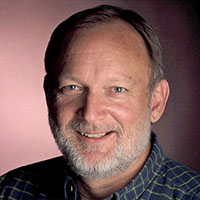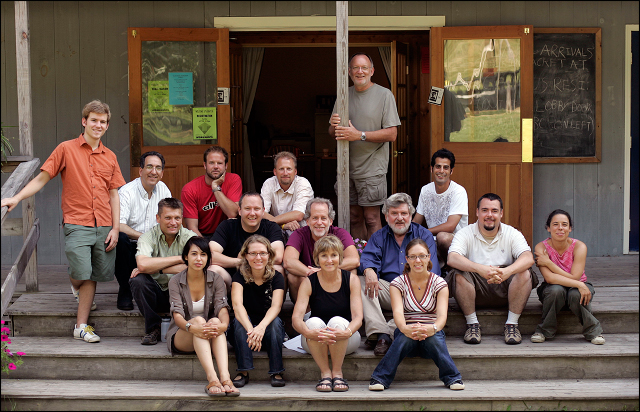 |
→ August 2007 Contents → Special Report
|
The Platypus Workshop, Maine Media Workshops
July/August 2007
|
 |
|
What's a platypus? By definition, it's an Australian aquatic egg-laying mammal, having a soft pliable bill shaped like a duck's, webbed feet, and sleek grey fur – at least that is what I told my co-workers at the Palm Beach Post when I signed up for a Platypus Workshop. I had no idea of what I was getting into.
The old-time newspaper model is to report stories and shoot photographs. Editors assigned stories and photos. Copy editors wrote headlines, captions, designed the layout and used proportion wheels and pica poles to size photos.
Everything was on paper: stories, photos, captions and headlines. They were sent to the "backshop" where they were pasted onto a page. The page was photographed and burned into a printing plate that went on the press. The press started printing around midnight and the newspaper relied on a 12-year-old kid to deliver it to your doorstep.
One big problem with the old model – the news is anywhere from 12 to 24 hours old by the time you read it.
Newspaper circulation in the United States peaked in 1984. Ever since, newspapers have been in a slow spiral of death.
Today, people want news NOW! There are hundreds of TV stations that broadcast around the clock or break into regular programming when Paris Hilton gets out of jail. You can get news anywhere – on your satellite car radio, on your cell phone, on your iPod and on your computer. Newspapers are competing for time with all this new media.
The Internet has changed our lives in many ways, and it has changed newspapers forever.
Newspapers are in danger. Display advertisers are fleeing. Space is shrinking. Subscribers are disappearing. Why buy a classified ad in a local paper when you can sell an item to anyone in the world by listing it on eBay? You can get movie listings and even buy tickets online without looking at a newspaper. You can even buy a car online and search for the model you want faster than you could ever read listings in a newspaper.
Newspapers must change if they are to survive.
As part of our newspaper's change, the editors of the Palm Beach Post asked me to lead a project to place more video on our Web site. I had shot video for a few years, doing a few short pieces for our Web site, using a small Sony camera and editing in iMovie. I took on the new assignment with one stipulation: they must send me to the Platypus Workshop.
So I arrive in Maine to learn on the first night that traditional photojournalism is dying. A new language of visual journalism must take its place: video journalism.
The instructors are Dirck Halstead – a virtual Photo God – a photojournalist who has covered every historical event from the fall of Saigon to the famous shot of Monica Lewinsky hugging Bill Clinton. His sidekick is PF Bentley – an incredible photojournalist and teacher. Together they act like an old married couple, arguing back and forth about this or that, but the end result is always the same: Dirck does it the old way; PF does it the new way.
Halstead saw the future in 1997. Ahead of the curve, he realized the Internet and Web would change traditional photojournalism. He has taught 19 Platypus Workshops and taught hundreds of photojournalists how to transition to the future with video journalism.
The workshop is an intense two-week boot camp. The first thing I get is a Canon HX-A1 high-definition video camera. With a giant wide-angle lens. And a tripod. And a remote control, batteries, chargers, adapters, wireless microphone, shotgun microphone, cables, tripod, fluid head, lights and more.
I am sent off to shoot a series of video exercises that drive me crazy. The first thing I have to shoot is a Man on the Street, but now it is called Vox Pops. OK, I think, this isn't too hard. But my audio is bad. I am in a noisy place and not paying attention to audio, which I learn is the most important part of video journalism.
Next I have to shoot "B roll" video at a vacuum cleaner shop. It is the most boring place in the world. How the hell am I going to make it interesting? I deviate from the assignment and Dirck and PF chew me out. But I did learn what to do. Some things are finding home in a brain crevice.
Now I have to "cut carrots." OK, now I am learning to shoot repetitive action. I am shooting over, under, inside, outside, realizing I must shoot all these angles to make a video I can edit.
It's getting harder. I have an afternoon to find a character that will make a 1-minute story. I go to the local bookstore without any gear and strike up a conversation with the owner. He's very boring. I introduce myself to an elderly gentleman and find out he is the famous landscape photographer, Paul Caponigro. He invites me to his home. I am both thrilled and nervous. I spend two hours with him and am thinking clearer.
I learn a new way of thinking about compressing time. I thought 1/500th of a second compressed time! When I go on an assignment for the newspaper I know the angles to shoot from. With video, I have to learn to "cut carrots" and I am not talking about making soup--I am talking about making a video you can edit. Every day I learn how to shoot "A roll and B roll" and realize that I have to shoot way more sequences on video than I have to when shooting stills. I must calm down, do tai chi exercises in my brain, which is already about to explode because of information overload.
Now it's time to work on the final project. I have a solid idea and have done my research in the little bit of time during breaks. I am going to shoot the retiring kayaking postmaster of Spruce Head, Maine, on his last day of work.
Batteries are charged, lens is clean, new batteries in the microphones and I am off for three days of shooting. It is the hardest thing I have done in my 32-year career at the newspaper. Now I am thinking about cutting carrots, A roll and B roll, sequences and more. I am paying attention to the audio, the lighting, my motivated pans, my tilts and more. I think it is starting to pay off.
Four hours of tape and I am sitting at the computer, capturing and logging the video. Twelve- hour days turn into 18-hour days as PF teaches me Final Cut Pro – Photoshop on steroids.
I struggle. I am obsessed. I watch the video pictures hundreds of times, over and over again. I cannot sleep at night. I talk, breathe, eat, sleep, dream my video story. It never ends.
I spend 28 hours in front of the computer struggling with the video editing software. PF and the teaching assistants help tremendously. The audio is tweaked and I am finished. We burn the project and wait for the next critique to find out how I did.
What have I learned in two weeks of Platypus?
I've learned the basics of how to operate a high-definition video camera and the basics of Final Cut Pro. But more importantly, I learned how much I want to do this, to be on the front line as the newspaper turns into a content provider rather than words and photos printed on paper. I want to be a storyteller, finding, shooting, editing and publishing interesting, compelling stories that will drive viewers to our Web site.
I want to deliver the content to our viewers instead of having a 12-year-old kid delivering the newspaper.
© John J. Lopinot
|
|
Back to August 2007 Contents
|
|
